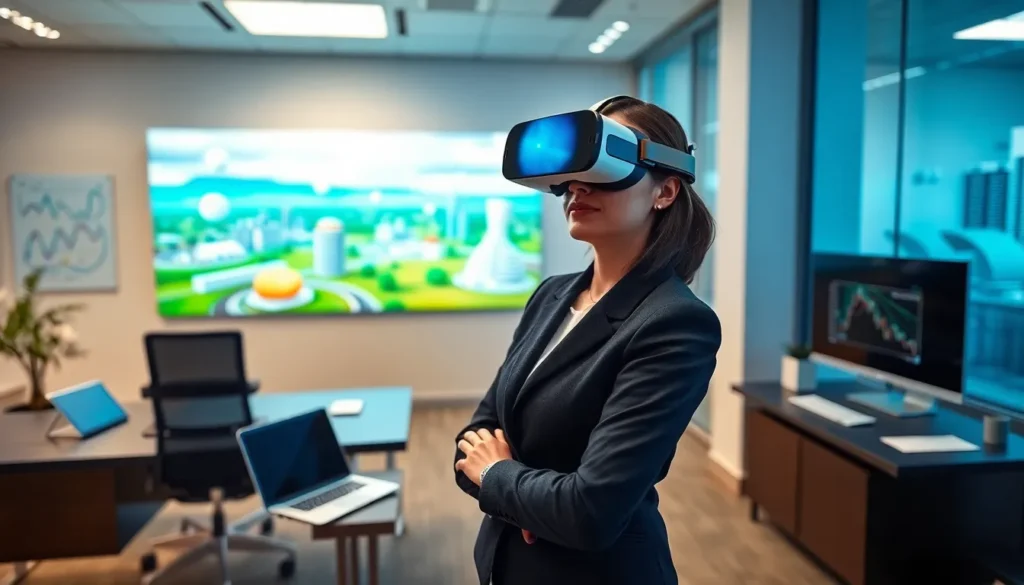Table of Contents
ToggleImagine strapping a device to your head and being transported to a different realm, where reality blurs with fantasy. Welcome to the world of virtual reality (VR), where the impossible becomes possible, and your wildest dreams take form. From gaming escapades to revolutionary medical practices, VR isn’t just a trend: it’s a game-changer. Let’s jump into the fascinating universe of virtual reality applications, exploring its history, current trends, and what the future holds for this astounding technology.
Overview of Virtual Reality

Virtual reality, often abbreviated as VR, refers to a computer-generated environment that immerses users in a three-dimensional, interactive setting. While the term might seem modern, its roots trace back to the 1960s when the first VR machine, the Sensorama, was created. This pioneering device combined sights, sounds, and even smells to enhance the user’s experience, laying the groundwork for today’s cutting-edge technologies.
Historical Development
The evolution of VR has been nothing short of remarkable. After the early days, the technology saw sporadic advancements, but it wasn’t until the 1990s that VR became more mainstream, particularly in gaming. Companies like Sega and Nintendo experimented with virtual headsets, sparking a love affair between gamers and immersive experiences. Fast forward to the 21st century, and major tech players like Oculus and HTC have transformed VR into a powerful tool employed across various sectors beyond just gaming.
Key Technologies Behind VR
At the heart of virtual reality are several key technologies. High-resolution displays play a crucial role, providing crystal-clear images that enhance immersion. Also, motion tracking systems allow users to interact with their environment seamlessly, creating a more realistic feel. The latest developments, including haptic feedback and spatial audio, add layers of depth, making experiences even more lifelike. Each technology works harmoniously to push boundaries, making virtual reality a captivating frontier of innovation.
Current Trends in Virtual Reality
As virtual reality technology advances, its applications continue to expand into diverse areas. Here are some of the most exciting current trends in VR:
Gaming and Entertainment
Unquestionably, gaming has been one of the primary drivers for the adoption of virtual reality applications. Titles like Beat Saber and Half-Life: Alyx have demonstrated how immersive gameplay can elevate the gaming experience beyond conventional platforms. Gamers can now literally step into their favorite worlds, interact with characters, and manipulate objects as if they were real.
Education and Training
Education is undergoing a revolutionary change thanks to VR technology. Schools and training centers have recognized the potential of immersive learning experiences. Virtual classrooms allow students to explore historical events or conduct scientific experiments without leaving their desks. Meanwhile, industries like aviation and healthcare use VR simulations for training purposes, dramatically reducing risks associated with real-world training.
Healthcare Innovations
Healthcare is another giant benefitting from the VR boom. Virtual reality applications allow for medical training without putting patients’ lives at risk. Surgeons can practice complex procedures through simulations, improving their skills while reducing the likelihood of mistakes in real-life operations. Also, VR helps in pain management and rehabilitation, offering patients alternative treatments that aid their recovery processes.
Real Estate and Architecture
In real estate, VR is changing how properties are showcased. Virtual tours let potential buyers explore homes and buildings without any physical presence, saving time and resources. Similarly, architects are embracing VR to visualize and iterate designs in real-time, allowing for immediate feedback and refinements that lead to better outcomes.
Future Prospects of Virtual Reality
Looking ahead, the future of virtual reality applications appears promising, but challenges remain on the horizon.
Challenges and Limitations
Even though its potential, virtual reality faces several challenges. Accessibility is a primary hurdle: while costs are decreasing, high-quality VR equipment can still be prohibitively expensive for the average consumer. Also, issues related to motion sickness and the technical complexity of VR setups hinder mass adoption.
Potential Impact on Various Industries
But, as technology evolves, the potential impact of VR on various industries is enormous. In the entertainment sector, a blend of augmented reality (AR) and VR could lead to a new wave of interactive experiences in films and theme parks. Meanwhile, the corporate world anticipates VR transforming remote work by enhancing virtual meetings and collaborations in immersive environments. With ongoing research and innovation, the prospects for virtual reality applications are vast, paving the way for advancements we can only begin to imagine.







